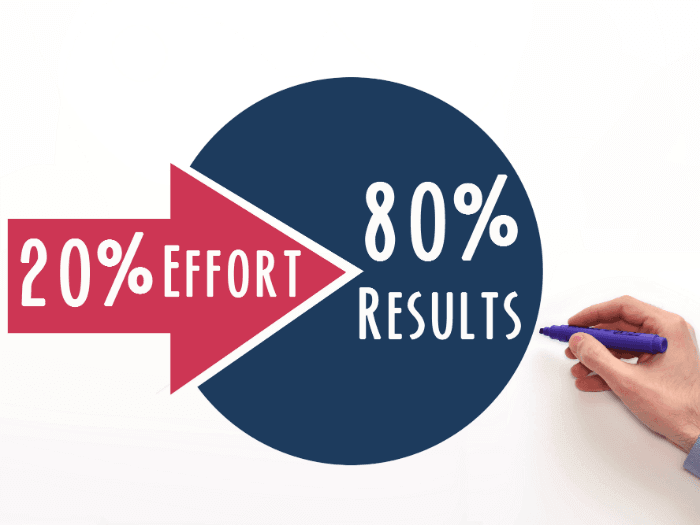The wisdom of life consists in the elimination of non–essentials. – Lin Yutang
The Pareto Principle (also known as the 80/20 rule, law of the vital few), named after Italian economist Vilfredo Pareto who noted that 80% of consequences comes from 20% of the causes (the “vital few). Pareto made the observation at the University of Lausanne in 1896. In his first work Cours d’économie politique, he showed that approximately 80% of the land in Italy was owned by 20% of the population. The top 20% of the population had 80% of the wealth in Italy.
The Pareto Principle, states that 20 percent of the things you do account for 80 percent of the value of what you accomplish. This means that 80 percent of what you do is worth 20 percent or less of the value of what you accomplish.
The Pareto Principle appears in every sphere of life from our relationships (You spend 80% of your time with 20% of your friends), Business (20% of your clients gives you 80% of the Business), 20% of your clothes get worn 80% of the time, etc. The key is to identify the 20% (the vital few) that is bringing 80% of the results. I have found that the key to succeeding in life is to do more of what works and less of what does not work. Focus on the vital few and reduce the trivial many, understand that motion is not the same thing movement, revenue is not profit, progress is not linear, it takes time -You have to trust the process.
It is not enough to be busy. So are the ants. The question is: What are we busy about? – Henry David Thoreau
British Management Consultant and Author, Richard Koch writes in his book: The 80/20 Principle: The Secret to Achieving More with Less:
The 80/20 Principle asserts that a minority of causes, inputs, or effort usually lead to a majority of the results, outputs, or rewards. Taken literally, this means that, for example, 80 percent of what you achieve in your job comes from 20 percent of the time spent. Thus for all practical purposes, four-fifths of the effort—a dominant part of it—is largely irrelevant. This is contrary to what people normally expect. So the 80/20 Principle states that there is an inbuilt imbalance between causes and results, inputs and outputs, and effort and reward.
Variations of the 80/20 Principle
1949: Zipf’s Principle of Least Effort
Zipf’s principle said that resources (people, goods, time, skills, or anything else that is productive) tended to arrange themselves so as to minimize work, so that approximately 20–30 percent of any resource accounted for 70–80 percent of the activity related to that resource.
1951: Juran’s Rule of the Vital Few and the rise of Japan
The other pioneer of the 80/20 Principle was the great quality guru, Romanian-born U.S. engineer Joseph Moses Juran (born 1904), the man behind the Quality Revolution of 1950–90. He made what he alternately called the “Pareto Principle” and the “Rule of the Vital Few” virtually synonymous with the search for high product quality. His great idea was to use the 80/20 Principle, together with other statistical methods, to root out quality faults and improve the reliability and value of industrial and consumer goods.
In The Tao of Warren Buffett: Warren Buffett’s Words of Wisdom, Mary Buffett, and David Clark write:
“You only have to do a very few things right in your life so long as you don’t do too many things wrong.”
The principles of life and investing often parallel each other. To succeed in life you really only have to get a few things right. The only way that you can screw it up is to make a series of bad decisions. That doesn’t mean that you can’t make mistakes, you just can’t make too many big ones.
The same goes for investing. Make a few right investments and you can make a fortune. But every time you make an investment decision, there is a chance that you will get it wrong. Make a few bad ones and you will eventually wipe out the gains from the few good ones you made.
Warren decided early in his investing career that it would be impossible for him to make hundreds of right investment decisions, so he decided that he would invest only in the businesses that he was absolutely sure of and then bet heavily on them. He owes 90% of his wealth to just ten of these. Sometimes what you don’t do is just as important as what you do.
Sometimes what you don’t do is just as important as what you do.
Author John C. Maxwell in his book, Developing the Leader Within You 2.0 highlights 6 ways of applying the Pareto principle to the people on your team:
• Determine which people are the top 20 percent when it comes to production.
• Spend 80 percent of your people time with this top 20 percent.
• Spend 80 percent of your personal development dollars on this top 20 percent.
• Help the top 20 percent to determine what their top 20 percent return is, and allow them to give 80 percent of their time to it.
• Allow them to delegate the other 80 percent of their tasks to others to free them up for what they do best.
• Ask the top 20 percent to do on-the-job training for the next 20 percent.
The 80/20 Principle in practice:
- 20 percent of your priorities will give you 80 percent of your production IF you spend your time, energy, money, and personnel on the top 20 percent of your priorities.
- Time: 20 percent of our time produces 80 percent of our results
- Counseling: 20 percent of the people take up 80 percent of our time
- Products: 20 percent of the products bring in 80 percent of the profits
- Books: 20 percent of the book contains 80 percent of the content
- Jobs: 20 percent of our work gives us 80 percent of the satisfaction
- Speeches: 20 percent of the presentation creates 80 percent of the impact
- Donors: 20 percent of the donors give 80 percent of the money
- Taxes: 20 percent of the people pay 80 percent of the taxes
- Leadership: 20 percent of the people make 80 percent of the decisions
- Picnics: 20 percent of the people will eat 80 percent of the food
- The top 20 percent of your staff give you an 80 percent return: focus your time and energy on them.
- The top 20 percent of your clients give you 80 percent of your return: focus on them.
- The top 20 percent of your offerings produce 80 percent of your return: focus on selling them.
In the 80/20 Principle, Author Richard Koch writes – Application of the 80/20 Principle implies that we should do the following:
- celebrate exceptional productivity, rather than raise average efforts
- exercise control over our lives with the least possible effort
- be selective, not exhaustive
- strive for excellence in few things, rather than good performance in many
- only do the thing we are best at doing and enjoy most
- look beneath the normal texture of life to uncover ironies and oddities
- in every important sphere, work out where 20 percent of effort can lead to 80 percent of returns
- calm down, work less and target a limited number of very valuable goals where the 80/20 Principle will work for us, rather than pursuing every available opportunity.
- make the most of those few “lucky streaks” in our life where we are at our creative peak and the stars line up to guarantee success.
All the Best in your quest to get Better. Don’t Settle: Live with Passion.



1 Comment
Pingback: On Priorities. – Lanre Dahunsi